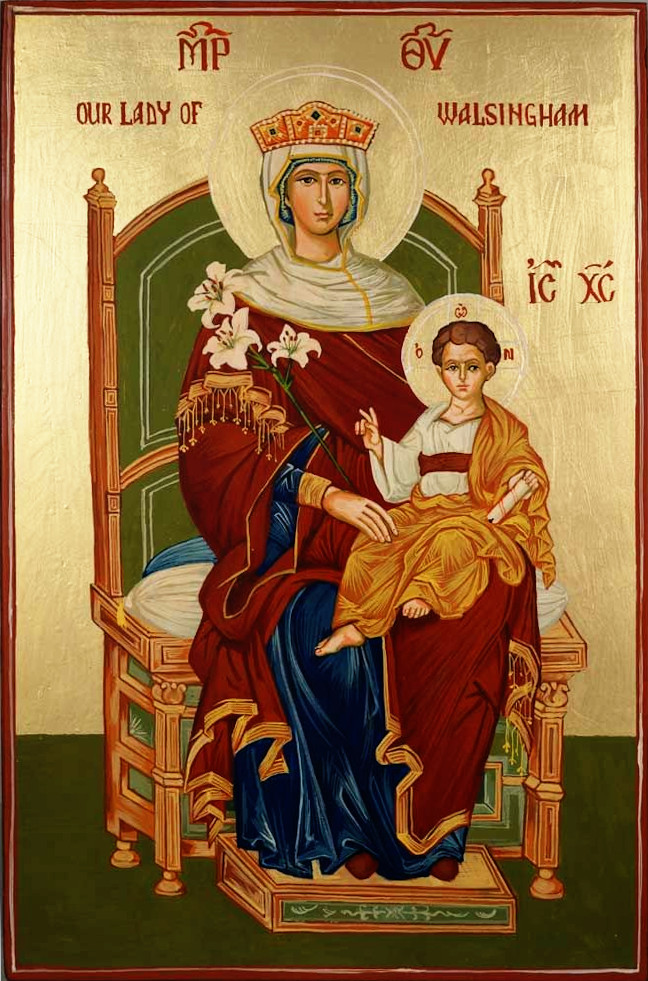15 June 2019
Venerable Éadburg of Winchester
On the fifteenth of June in the Orthodox Church we venerate the holy English princess and monastic Éadburg of Winchester – not to be confused with the Abbess of Minster-in-Thanet (and friend of Saint Boniface) of the same name.
The Saint Éadburg whom we are concerned with here is the daughter of Éadweard the Elder, King of England (in turn the son of Saint Ælfræd the Great), and his third wife Éadgifu of Kent, born around the year 920. She was left some land in Hampshire by her half-brother Æþelstán, but she had been given at the age of three as an infant oblate (as was then a common custom) to the Benedictine Abbey of Saint Mary’s at Winchester, which had been founded by her grandfather and grandmother Ealhswíþ. This was apparently decided in a custom very similar to the contemporary Chinese tradition of zhuazhou 抓周 which in China’s old society was held on the child’s first birthday to determine his future. Ten or eleven objects would be placed in front of the young child, and the one which the child chose to play with would supposedly foretell the child’s personality and career.
In young Éadburg’s case, the cognate Old English custom was celebrated on the little girl’s third birthday. Éadweard King placed before his daughter the symbols of royalty, various objects representing various trades, and finally the Chalice, the collection plate and the holy books of the Church. Little Éadburg did not pay the slightest attention to the objects representing a worldly career, and instead chose to play with the religious objects. From this it was foretold that she was destined for a life of holy seclusion and contemplation. She was thereafter entrusted to Abbess Æþelþrýð of Saint Mary’s for her upbringing and education.
Her hagiographer, Osbert of Clare, narrates her way of life in the convent. She was studious and humble. At one time, the prioress at Winchester found a nun sitting by herself and reading alone, which was forbidden and against the abbey rule. The prioress began to beat the nun, and stopped only when she recognised it was Éadburg, and prostrated herself before Éadburg in apology. (This may have been because of Éadburg’s high birth and political worth to the nunnery.) However, Éadburg forgave the prioress gladly and did not bear a grudge against her superior for her treatment, which she accepted as admonishment.
She also rose in the middle of the night – repeatedly and against the wishes of her superiors – to scrub clean the shoes of her fellow nuns. The abbess thought this was beneath her royal dignity, yet she continued to do it. At one time Éadweard King made a secret visit to Winchester to check on his beloved daughter’s life and happiness, and the nuns all had good things to say of her. Sensing that they were holding something back from him, Éadweard King pressed them on the issue, and after a time they disclosed to him his daughter’s behaviour of rising at night in secret to clean her sisters’ shoes. Instead of being angry as they expected him to be, Éadweard King was in fact delighted to hear of this. After this the nuns did not discourage her from this habit of humility.
Éadweard made yet another trip to Winchester in the open, and asked of his daughter to sing a song for him during the night’s entertainment. In this she was most unwilling at first, but her father insisted and indeed promised her anything she wanted if she would sing for him. At long last she was prevailed upon to offer her sweet voice to the task, but – again demonstrating her selflessness and her care for her sisters – the gift she asked of her father was not for herself but for the whole monastery: a royal estate at All Cannings in Wiltshire, which was among the properties of Saint Mary’s listed in the Domesday Book after the Norman Conquest.
Éadburg was also most generous to the poor, and ministered to the sick with her own hands. Osbert of Clare attributes to her five wonders. She healed a lame beggar in Winchester of his infirmity, and later cured a clerk from Saint Quentin’s of a bout of insanity which afflicted him as he was travelling through Winchester. She performed a successful exorcism upon a poor man from Wilton, and cured two other poor women of unknown residence. She also set free from his chains a man wrongly cast into prison by her father.
Saint Éadburg reposed at the age of forty, on the fifteenth of June, 960, and she was buried outside the church. For the five nights following her burial, the nun charged with closing the church window overlooking the graveyard was dismayed every night as it blew open – this was taken for a sign that she was displeased with her resting-place. The nuns took her casket and moved her inside the church, near the choir loft. Again Éadburg was displeased, and showed it by appearing herself to the nuns in a dream. They took up her casket and opened it, finding her relics to be intact and incorrupt. She was thereafter translated into the abbey church near the altar, where thereafter she rested.
Her sanctity was recognised locally by the bishop Æþelwold, who had heard the tales of the wonders she had wrought and sent investigators to the Benedictine nunnery. Unfortunately, the church in which Saint Éadburg was buried burned to the ground in 1141, during the Anarchy (the civil war between Empress Maud and King Stephen). The memory of the holy nun Éadburg was, however, kept intimately by the English Church prior to the Norman invasion. Holy and humble Éadburg, venerable nun and beloved sister, pray unto Christ our God that our souls may be saved!
Labels:
Anglophilia,
Britannia,
culture,
history,
Huaxia,
mediæval nonsense,
Pravoslávie,
prayers
Subscribe to:
Post Comments (Atom)














No comments:
Post a Comment